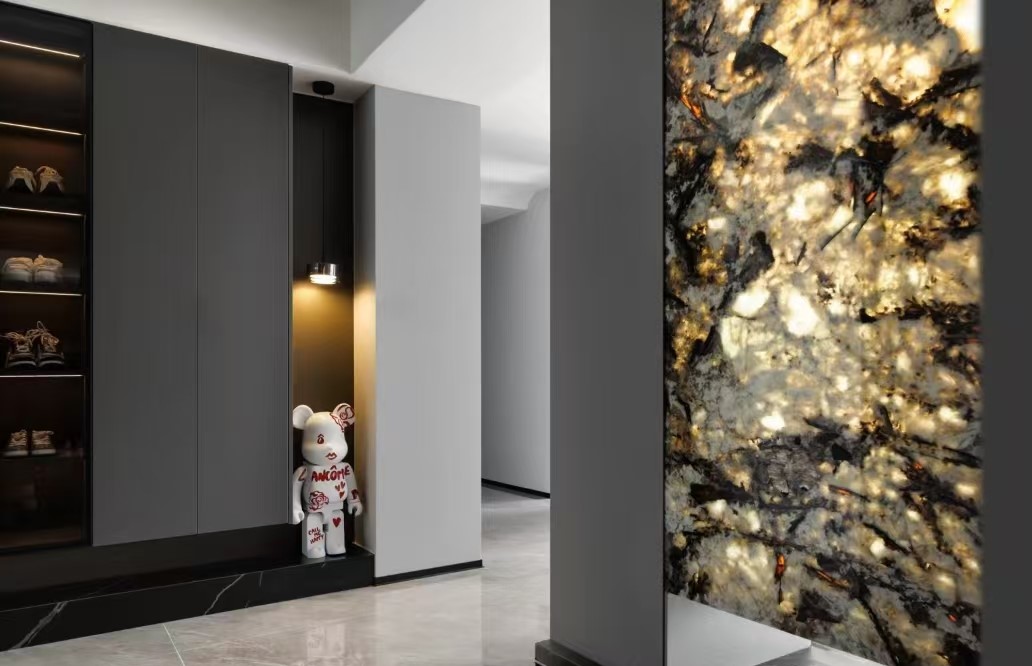Have you ever been mesmerized by the warm glow that shines through marble or agate? This wonderful effect of light and shadow makes one question how stone may be so “translucent”. Though translucent stone’s special visual characteristics define this phenomena rather than magic. How therefore does translucent stone work? In this article, we will take a deep dive into the working principle of translucent stone, unravel the scientific mystery behind it, and let you know more about these fascinating natural materials.
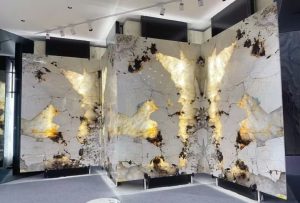
Exhibition of finished translucen stone products
What is translucent stone?
translucent stone, or more accurately translucent stone, refers to natural stones that have a certain degree of light transmission. Usually comprising marble, agate, quartzite, and some unique jade, these stones These stones are special in that they let some light flow through while preserving their natural color and texture. This property makes translucent stone widely used in architecture and interior design, especially in places where you need to create a warm atmosphere or highlight artistic effects.
How does light penetrate stone?
To understand how translucent stone works, you must first understand how light penetrates solid materials. Generally speaking, light interacts with solid materials in a range of ways including scattering, refraction, reflection and absorption. These optical effects cooperating produce the light transmittance of translucent stone.
1.Scattering of light: Tiny particles and impurities inside the stone cause light to scatter during propagation. Still, some light can pass these challenges and keep on spreading. The light transmittance is better and the effect of light scattering is less the more homogeneity and purity of the stone are.
2.Refraction of light: When light passes from one medium (such as air) to another medium (such as stone), refraction occurs, that is, the light changes its propagation direction. Various kinds of stone have varied refractive indices, so the path and speed of light propagation inside them will be different. Because the light propagation in lower refractive index stones is less hampered, their light transmittance often is superior.
3.Reflection of light: Some light is reflected back by the surface of the stone when it enters it, instead of entering the stone. The surface polish, texture and color of the stone determine the reflectance of this section of the light. Lower reflectivity of smooth, brilliant surfaces often results from which light transmittance is raised.
4.Absorption of light: The color and chemical composition of the stone affect the degree of light absorption. Usually absorbing more light, dark stones have low light transmission. Transmittance of light-colored or more translucent stones is superior since they absorb less light.
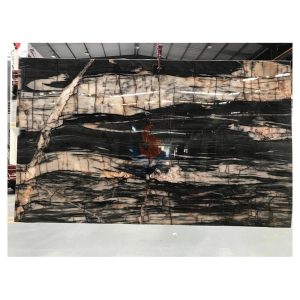
Factory Supply Translucent Brazilian Natural Stone Black Quartzite Big Slabs
Stone internal structure and light transmittance
The light transmittance of stone depends not only on the physical effect of light, but also on its internal structure. The path and method of light propagation in the stone depends on its microstructure, so the light transmittance of various kinds of stone differs greatly.
1.Crystal structure: translucent stone is usually composed of tiny crystals, and the arrangement of these crystals has an important influence on the propagation of light. The light transmittance is better the tighter the crystal structure since it reduces the interference the light experiences when it spreads in it. Marble and quartzite, for instance, have rather strong crystal formations, which increases their light transmission.
2.Impurities and defects: Impurities and tiny cracks in the stone scatter light, thereby reducing light transmittance. This is the reason high purity stones free of few contaminants are typically more costly. Agate and jade usually have better light transmittance because of their relatively pure internal structure.
3.Thickness: The thickness of the stone is also an important factor affecting light transmittance. Usually, thinner stones transmit more light since light is less absorbed and scattered as it passes through them. To get the finest visual impact, designers may pick thinner stones for embellishments needing backlighting.
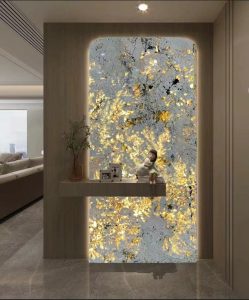
Translucen stone used in interior decoration
Application of translucent stone
translucent stone has been extensively applied in modern architecture and interior design because of its special light transmission. Here are some common application scenarios:
1.Backlit wall: By installing a light source behind the translucent stone, you can create a stunning visual effect.This design is often used in the decoration of hotel lobbies, restaurants and high-end residences, making the space full of modernity and luxury.
2.Countertops and bars: translucent stone used in the kitchen or bar area will add originality to these useful spaces. With the backlit design, the stone countertop can present rich colors and textures, increasing the visual appeal.
3.Art installation: translucent stone is often used to create art installations or sculptures due to its light transmittance and unique beauty. Dynamic visual effects created by designers using the variations of light and shadow make the works more vibrant and interesting.
4.Building exterior wall: Some modern buildings use translucent stone as the exterior wall material, showing the characteristics of solidity and stability during the day, and showing lightness and transparency at night through the built-in light source. This architecture not only improves the building’s recognition but also is rather lovely.
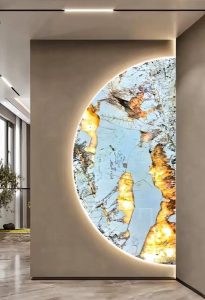
Light and shadow art of translucent stone
The magic of translucent stone is that it can perfectly combine light with solid materials to create rich visual effects. From physical concepts to useful applications, we may observe that translucent stone is an art of light and shadow as much as a piece of stone. Transparency stone will be applied increasingly widely in next building and design. They not only decorate our space, but also light up our lives.
Frequently Asked Question (FAQ)
What is the price of translucent stone?
Translucent stones can range in price from a few hundred yuan to thousands of yuan depending on the type, origin, processing method, and design requirements.
Common types include marble, agate, jade, quartzite, and kyanite.
Marble is expensive due to its pure color, fine texture, and light transmittance, while agate is expensive due to its rich colors and unique textures.





